Alfa Romeo 156 2006 Owner handbook (in English)
Manufacturer: ALFA ROMEO, Model Year: 2006, Model line: 156, Model: Alfa Romeo 156 2006Pages: 357, PDF Size: 5.04 MB
Page 171 of 357
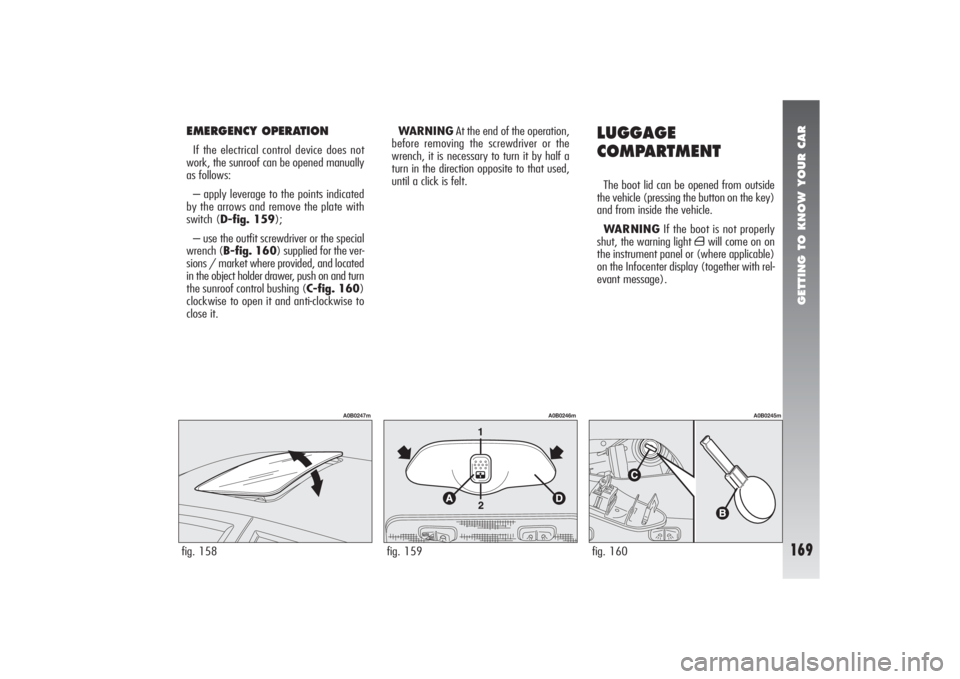
GETTING TO KNOW YOUR CAR
169
fig. 158
A0B0247m
EMERGENCY OPERATIONIf the electrical control device does not
work, the sunroof can be opened manually
as follows:
– apply leverage to the points indicated
by the arrows and remove the plate with
switch (D-fig. 159);
– use the outfit screwdriver or the special
wrench (B-fig. 160) supplied for the ver-
sions / market where provided, and located
in the object holder drawer, push on and turn
the sunroof control bushing (C-fig. 160)
clockwise to open it and anti-clockwise to
close it. WARNINGAt the end of the operation,
before removing the screwdriver or the
wrench, it is necessary to turn it by half a
turn in the direction opposite to that used,
until a click is felt.
LUGGAGE
COMPARTMENTThe boot lid can be opened from outside
the vehicle (pressing the button on the key)
and from inside the vehicle.
WARNINGIf the boot is not properly
shut, the warning light
´
will come on on
the instrument panel or (where applicable)
on the Infocenter display (together with rel-
evant message).
fig. 159
A0B0246m
fig. 160
A0B0245m
Page 172 of 357

GETTING TO KNOW YOUR CAR
170
Lifting the boot lid is made easier by the
action of gas springs.
OPENING WITH REMOTE
CONTROL
(fig. 162)
The luggage compartment can be opened
by remote control from outside pressing the
button (C), also when the electronic alarm
is on (where applicable).
In this case, the alarm system switches off
volumetric protection and the boot lid con-
trol sensor. The system also sounds two
beeps and the arrows light up for about
three seconds (with the exception of ver-
sions for certain markets).
Closing the boot again the control functions
are restored, the system sounds two beeps
and the arrows light up for about three sec-
onds (with the exception of versions for cer-
tain markets). the gas springs are cali-
brated to guarantee correct
operation with loading
specified by the manufacturer. Ar-
bitrary additions to the boot lid
(spoiler, etc.) may affect its oper-
ation and safety.
OPENING FROM INSIDE (fig. 161)
To open the boot from inside the passen-
ger compartment, pull the lever (A), at the
side of the driver’s seat.fig. 161
A0B0042m
fig. 162
A0B0743m
Only use the boot opening
lever with the vehicle sta-
tionary.
WARNING
Page 173 of 357

GETTING TO KNOW YOUR CAR
171
CLOSING THE BOOTTo close the boot, lower it and press down
above the locking mechanism until it is
heard to click into place.
BOOT LIGHTING
(fig. 163)
Opening the boot, the light (A) in the up-
per part of the boot turns on automatically.
The light goes out closing the boot or af-
ter a few minutes (about 15) if the boot is
left open. In this case, to turn it on again
close the boot, then open it again.
fig. 163
A0B0000m
fig. 165
A0B0243m
fig. 164
A0B0242m
SECURING THE LOAD(fig. 164-165)
The load carried may be blocked with
straps hooked to the special rings in the boot
corners.
The rings also serve to secure the luggage
retaining net (available upon request, for
versions/markets where applicable) c/o
Alfa Romeo Authorized Services.
Page 174 of 357
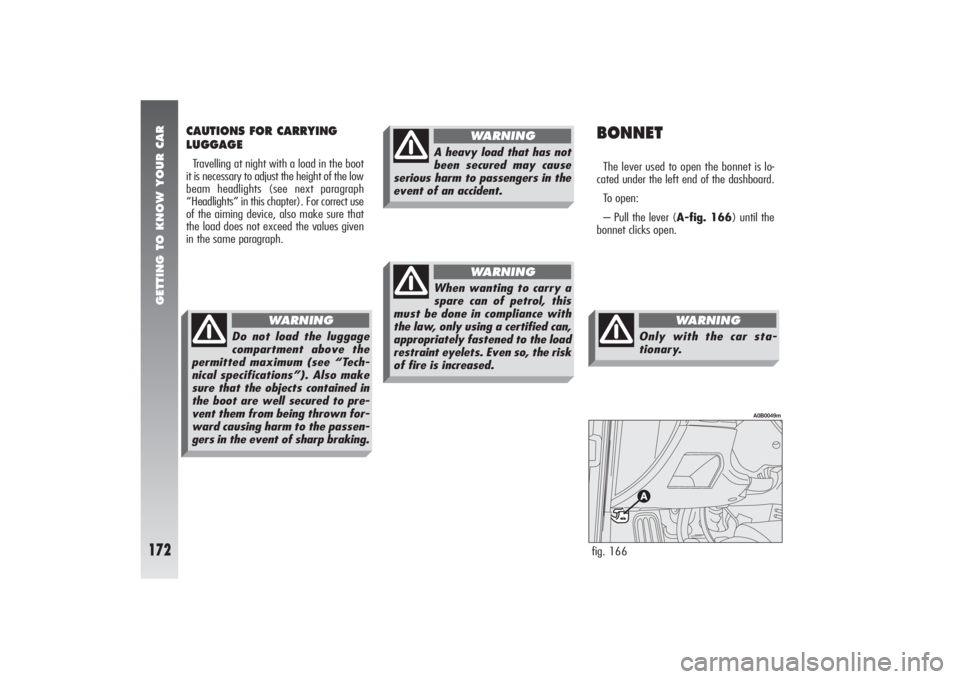
GETTING TO KNOW YOUR CAR
172
BONNETThe lever used to open the bonnet is lo-
cated under the left end of the dashboard.
To open:
– Pull the lever (A-fig. 166) until the
bonnet clicks open.
CAUTIONS FOR CARRYING
LUGGAGETravelling at night with a load in the boot
it is necessary to adjust the height of the low
beam headlights (see next paragraph
“Headlights” in this chapter). For correct use
of the aiming device, also make sure that
the load does not exceed the values given
in the same paragraph.
fig. 166
A0B0049m
Do not load the luggage
compartment above the
permitted maximum (see “Tech-
nical specifications”). Also make
sure that the objects contained in
the boot are well secured to pre-
vent them from being thrown for-
ward causing harm to the passen-
gers in the event of sharp braking.
WARNING
A heavy load that has not
been secured may cause
serious harm to passengers in the
event of an accident.
WARNING
When wanting to carry a
spare can of petrol, this
must be done in compliance with
the law, only using a certified can,
appropriately fastened to the load
restraint eyelets. Even so, the risk
of fire is increased.
WARNING
Only with the car sta-
tionary.
WARNING
Page 175 of 357
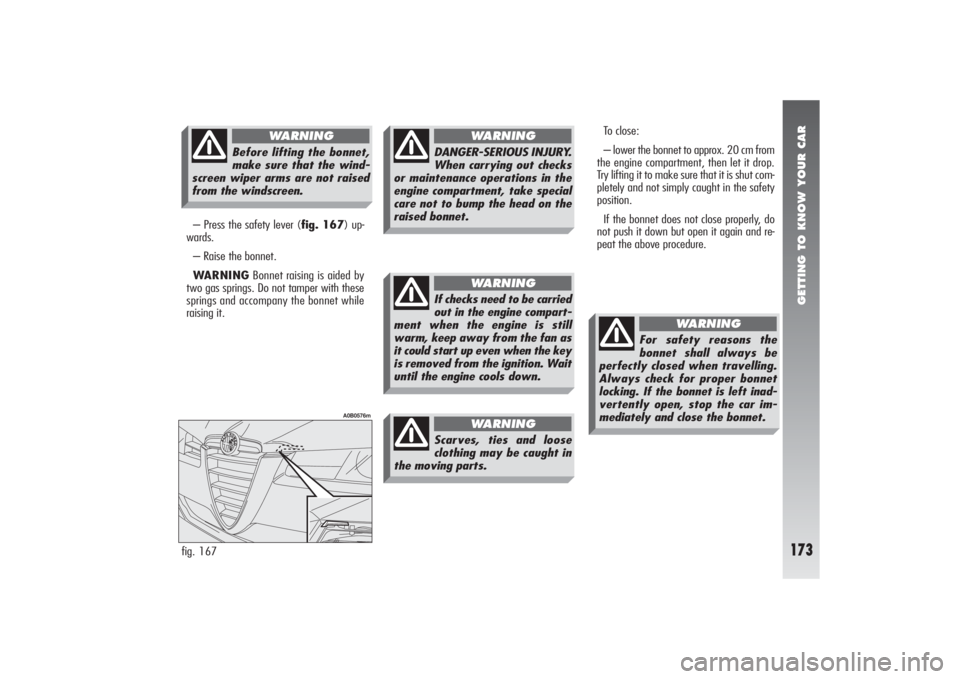
GETTING TO KNOW YOUR CAR
173
– Press the safety lever (fig. 167) up-
wards.
– Raise the bonnet.
WARNINGBonnet raising is aided by
two gas springs. Do not tamper with these
springs and accompany the bonnet while
raising it.
fig. 167
A0B0576m
Before lifting the bonnet,
make sure that the wind-
screen wiper arms are not raised
from the windscreen.
WARNING
DANGER-SERIOUS INJURY.
When carrying out checks
or maintenance operations in the
engine compartment, take special
care not to bump the head on the
raised bonnet.
WARNING
If checks need to be carried
out in the engine compart-
ment when the engine is still
warm, keep away from the fan as
it could start up even when the key
is removed from the ignition. Wait
until the engine cools down.
WARNING
Scarves, ties and loose
clothing may be caught in
the moving parts.
WARNING
To close:
– lower the bonnet to approx. 20 cm from
the engine compartment, then let it drop.
Try lifting it to make sure that it is shut com-
pletely and not simply caught in the safety
position.
If the bonnet does not close properly, do
not push it down but open it again and re-
peat the above procedure.
For safety reasons the
bonnet shall always be
perfectly closed when travelling.
Always check for proper bonnet
locking. If the bonnet is left inad-
vertently open, stop the car im-
mediately and close the bonnet.
WARNING
Page 176 of 357
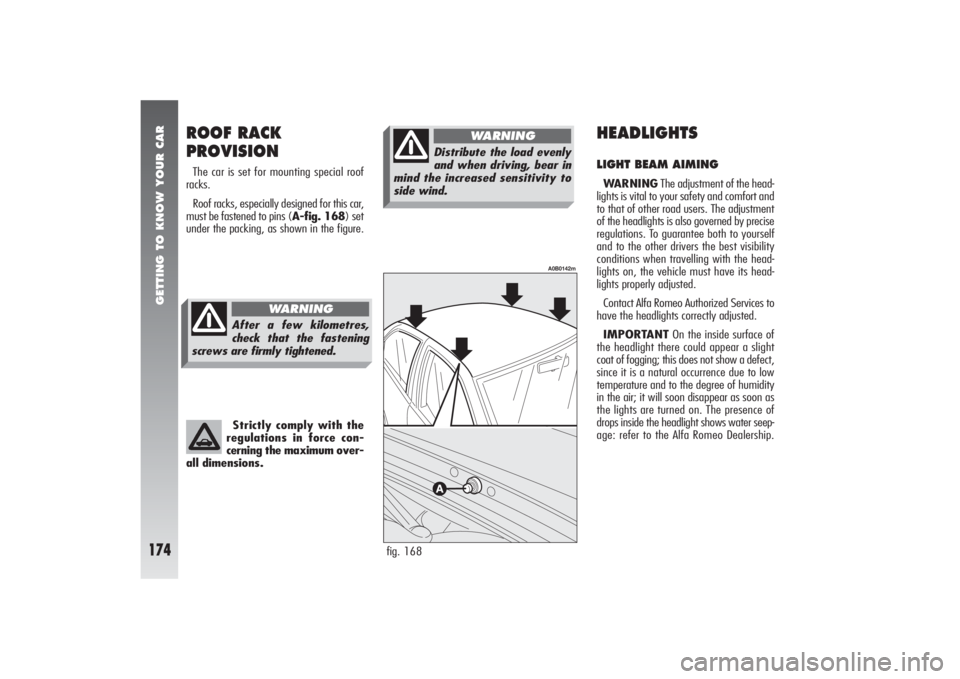
GETTING TO KNOW YOUR CAR
174
HEADLIGHTSLIGHT BEAM AIMINGWARNINGThe adjustment of the head-
lights is vital to your safety and comfort and
to that of other road users. The adjustment
of the headlights is also governed by precise
regulations. To guarantee both to yourself
and to the other drivers the best visibility
conditions when travelling with the head-
lights on, the vehicle must have its head-
lights properly adjusted.
Contact Alfa Romeo Authorized Services to
have the headlights correctly adjusted.
IMPORTANTOn the inside surface of
the headlight there could appear a slight
coat of fogging; this does not show a defect,
since it is a natural occurrence due to low
temperature and to the degree of humidity
in the air; it will soon disappear as soon as
the lights are turned on. The presence of
drops inside the headlight shows water seep-
age: refer to the Alfa Romeo Dealership.
ROOF RACK
PROVISIONThe car is set for mounting special roof
racks.
Roof racks, especially designed for this car,
must be fastened to pins (A-fig. 168) set
under the packing, as shown in the figure.
Strictly comply with the
regulations in force con-
cerning the maximum over-
all dimensions.
fig. 168
A0B0142m
After a few kilometres,
check that the fastening
screws are firmly tightened.
WARNING
Distribute the load evenly
and when driving, bear in
mind the increased sensitivity to
side wind.
WARNING
Page 177 of 357

GETTING TO KNOW YOUR CAR
175
COMPENSATION FOR TILT(fig. 169)
If the car is fitted with xenon headlights,
beam aiming is electronic and therefore con-
trol (A) on the mask near the steering col-
umn is not present.
When the vehicle is loaded, the beam from
the headlights is raised due to the back-
wards tilt of the vehicle.
In this case the headlights must be ad-
justed using control (A) located on the plate
at the side of the steering column.This control has four positions corre-
sponding to various vehicle loads given be-
low:
– position 0: 1 or 2 people occupying
front seats, full fuel tank, on-board equip-
ment present;
– position 1: 5 people on-board;
– position 2: 5 people on-board, luggage
compartment full (50 kg approximately);
– position 3: driver and 300 kg in lug-
gage compartment.fig. 169
A0B0240m
Check the positioning of
the headlight beams every
time you change the load to be car-
ried.
WARNING
ADJUSTING THE FRONT
FOGLIGHTS (for versions/markets where
applicable)
To adjust the height of the beam of the
front foglights, act on adjusting screw (A-
fig. 170).fig. 170
A0B0239m
Contact Alfa Romeo Au-
thorized Services to have
the headlights correctly ad-
justed.
Page 178 of 357

GETTING TO KNOW YOUR CAR
176
The electromechanical system to auto-
matically keep constant trim makes the
headlight tilt compensating device unnec-
essary.
The xenon lamps have very long life which
makes possible fault very unlikely.
If necessary, have the sys-
tem checked and repairs (if
any) made only by Alfa Romeo Au-
thorized Services.
WARNING
GAS DISCHARGE HEADLIGHTS(optional for versions/markets
where applicable)
The gas (xenon) discharge headlights op-
erate with a voltaic arc, in an ambient sat-
urated with pressure xenon, instead of the
glow filament.
The resulting illumination is sensibly higher
to that of conventional lamps, both for light
quality (clearer light) and for the width and
positioning of the illuminated area.
The advantages of better illumination can
be perceived (due to less eyesight fatigue
and greater orientation capacity for the dri-
ver, which in turn means higher driving
safety) especially in case of bad weather,
fog and/or insufficient road signs, thanks
to the better illumination of the side parts
of the visual field, normally obscured.The large increase of the side part illumi-
nation increases driving safety since it allows
the driver to better see the other users on
the edge of the road (pedestrians, cyclists
and bikers).
The triggering of the voltaic arc requires a
very high voltage, while subsequent power
supply can take place at a low voltage.
The headlights achieve their top luminos-
ity approx. 15 seconds after they are
switched on.
The intense light produced by this type of
headlights requires the use of an automatic
system to keep headlight trim constant and
avoid dazzling the vehicles coming from the
opposite direction in case of braking, accel-
eration or when carrying loads.
Page 179 of 357
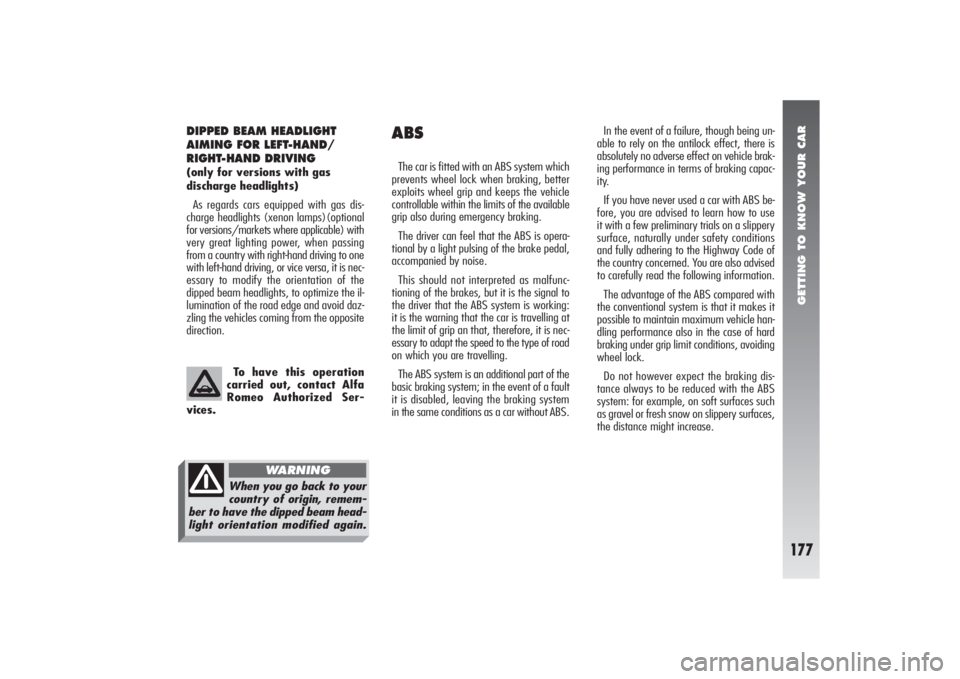
GETTING TO KNOW YOUR CAR
177
DIPPED BEAM HEADLIGHT
AIMING FOR LEFT-HAND/
RIGHT-HAND DRIVING(only for versions with gas
discharge headlights)
As regards cars equipped with gas dis-
charge headlights (xenon lamps)(optional
for versions/markets where applicable) with
very great lighting power, when passing
from a country with right-hand driving to one
with left-hand driving, or vice versa, it is nec-
essary to modify the orientation of the
dipped beam headlights, to optimize the il-
lumination of the road edge and avoid daz-
zling the vehicles coming from the opposite
direction.
To have this operation
carried out, contact Alfa
Romeo Authorized Ser-
vices.
When you go back to your
country of origin, remem-
ber to have the dipped beam head-
light orientation modified again.
WARNING
In the event of a failure, though being un-
able to rely on the antilock effect, there is
absolutely no adverse effect on vehicle brak-
ing performance in terms of braking capac-
ity.
If you have never used a car with ABS be-
fore, you are advised to learn how to use
it with a few preliminary trials on a slippery
surface, naturally under safety conditions
and fully adhering to the Highway Code of
the country concerned. You are also advised
to carefully read the following information.
The advantage of the ABS compared with
the conventional system is that it makes it
possible to maintain maximum vehicle han-
dling performance also in the case of hard
braking under grip limit conditions, avoiding
wheel lock.
Do not however expect the braking dis-
tance always to be reduced with the ABS
system: for example, on soft surfaces such
as gravel or fresh snow on slippery surfaces,
the distance might increase.
ABSThe car is fitted with an ABS system which
prevents wheel lock when braking, better
exploits wheel grip and keeps the vehicle
controllable within the limits of the available
grip also during emergency braking.
The driver can feel that the ABS is opera-
tional by a light pulsing of the brake pedal,
accompanied by noise.
This should not interpreted as malfunc-
tioning of the brakes, but it is the signal to
the driver that the ABS system is working:
it is the warning that the car is travelling at
the limit of grip an that, therefore, it is nec-
essary to adapt the speed to the type of road
on which you are travelling.
The ABS system is an additional part of the
basic braking system; in the event of a fault
it is disabled, leaving the braking system
in the same conditions as a car without ABS.
Page 180 of 357

GETTING TO KNOW YOUR CAR
178
Braking on corners always requires the ut-
most caution, even with the help of the ABS.
The most important piece of advice, how-
ever, is the following:Following these instructions you will be
in a condition to obtain peak braking per-
formance at all times.
WARNINGCars fitted with ABS must
only be fitted with wheel rims, tyres and
brake linings of the type and brand approved
by the Manufacturer.
The braking system is completed by the
electronic control braking distribution system
called EBD(Electronic Braking Force Dis-
tributor) which distributes the braking action
through the ABSsystem control unit and
sensors.
In the event of a system
fault, with lighting up of
the
>
warning light on the instru-
ment cluster (together with the
message + symbol shown by the
display), have the vehicle checked
immediately by Alfa Romeo Au-
thorized Services, driving slowly
to be able to regain full system
performance.
WARNING
When the ABS cuts in and
you feel the pedal pulse, do
not reduce the pressure, but keep
the brake pedal firmly pressed
with no fear; this way you will
stop in the shortest possible space,
compatibly with the conditions of
the road surface.
WARNING
The car is fitted with an
electronic brake distributor
(EBD). If the
>
and
x
warning
lights, where required, come on at
the same time (together with the
message + symbol shown by the
display) when the engine is run-
ning, there is an EBD system fault;
in this case, violent braking may
lock the rear wheels too early, with
the possibility of skidding. Drive
extremely carefully to the nearest
Alfa Romeo Authorized Services to
have the system checked over.
WARNING
In order to be able to exploit as far as pos-
sible the possibility of the antilock system
in the case of need, it is wise to follow a few
pieces of advice:
The ABS exploits the avail-
able grip in full, but it can-
not increase it; therefore, caution
is required on slippery surfaces,
without running unnecessary risks.
WARNING
If the ABS cuts in, it means
that the grip limit between
the tyres and the road surface has
been reached: it is necessary to
slow down and adapt driving to
the grip available.
WARNING